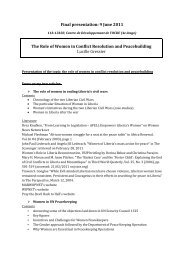Women's Economic Opportunity Index - Economist Intelligence Unit
Women's Economic Opportunity Index - Economist Intelligence Unit
Women's Economic Opportunity Index - Economist Intelligence Unit
- No tags were found...
You also want an ePaper? Increase the reach of your titles
YUMPU automatically turns print PDFs into web optimized ePapers that Google loves.
Appendix IWomen’s economic opportunityA new global index and rankingFurther ReadingM Tembon and L Fort (eds.), Girls’ Education in the 21st Century: Gender Equality, Empowerment and Growth(Directions in Development), World Bank: Washington DC, 2008.D Abu-Ghaida and S Klasen, “The <strong>Economic</strong> and Human Development Costs of Missing the MillenniumDevelopment Goal on Gender Equity”, World Development , Vol. 32, Issue 7, July 2004, pages 1075-1107.87. Based on internal rates ofreturn analysis. R Boarini andH Strauss, “The Private InternalRates of Return to TertiaryEducation: New Estimates for21 OECD Countries”, OECD<strong>Economic</strong>s Department WorkingPaper No. 591, OECD Publishing,2007. http://dx.doi.org/10.1787/031008650733.88. G Psacharopoulos and H APatrinos, “Returns to Investmentin Education: A Further Update”,Education <strong>Economic</strong>s, Vol. 12,No. 2, 2004.89. T Kurosaki and H Khan,“Human Capital, Productivity,and Stratification in RuralPakistan”, Review of Development<strong>Economic</strong>s, Vol. 10, No. 1,February 2006, pages 116-134.90. “Key Indicators 2007:Inequality in Asia”, AsianDevelopment Bank: Manila,2007.91. J R Behrman, N Birdsall andM Szekely, “<strong>Economic</strong> Policyand Wage Differentials in LatinAmerica”, Centre for GlobalDevelopment Working Paper 29,Washington DC, 2003.92. S Blondal, S Field and NGirouard, “Investment in HumanCapital through Upper Secondaryand Tertiary Education”, OECD<strong>Economic</strong> Studies, No. 34, 2002/I, OECD: Paris.93. M Aslam, G Kingdon andM Soderbom, “Is Education aPath to Gender Equality in theLabour Market? Evidence fromPakistan”, in M Tembon and LFort (eds.), Educating Girls forthe 21st Century: Gender Equality,Empowerment and <strong>Economic</strong>Growth, World Bank: WashingtonDC, 2008.Tertiary Education, womenBeyond primary and secondary education, higher learning has a large impact on earnings and jobprogression, especially for individuals employed in the non-farm sector. For OECD countries, the averageindividual returns of an additional year of tertiary education are 8-11%, 87 and this is even higher for manydeveloping countries where studies have been conducted. 88 For example, in rural Pakistan, non-farmwages of those with tertiary education are 49% higher than those of the uneducated, and 30% highereven when comparing between individuals with the same kind of job. 89 Furthermore, in India, Indonesia,the Philippines and Vietnam, the wage gap between those with a tertiary education and those withoutis rising significantly. 90 Evidence from Latin America suggests that returns from secondary and tertiaryeducation are going up more rapidly than those from primary education. 91An OECD study shows that workers with tertiary education are more likely to participate in the labourmarket, and have longer active working lives. This is especially true for women, where the gap in labourforce participation between women with upper secondary and tertiary education is wider than for men.The effects of education on female labour force participation are relatively wide in all age groups studied(25-64 years). 92In Pakistan, women get far more economic returns on education (defined as earning increment from anextra year of schooling) than for men in all occupations except agriculture. Therefore, education reducesgender gaps in earnings. However, women’s participation in the labour market increases only after tenyears of education—and only about 10% of Pakistani women have had ten or more years of education (asof the early 2000s). 93Further ReadingStephen Machin and Sandra McNally, “Tertiary Education Systems and Labour Markets”, commissioned bythe OECD Education and Training Policy Division for the Thematic Review of Tertiary Education, OECD: Paris,2007.Education For All - Global Monitoring Report, published annually by UNESCO since 2002. http://www.unesco.org/en/efareport/reports118 <strong>Economist</strong> <strong>Intelligence</strong> <strong>Unit</strong> 2010




